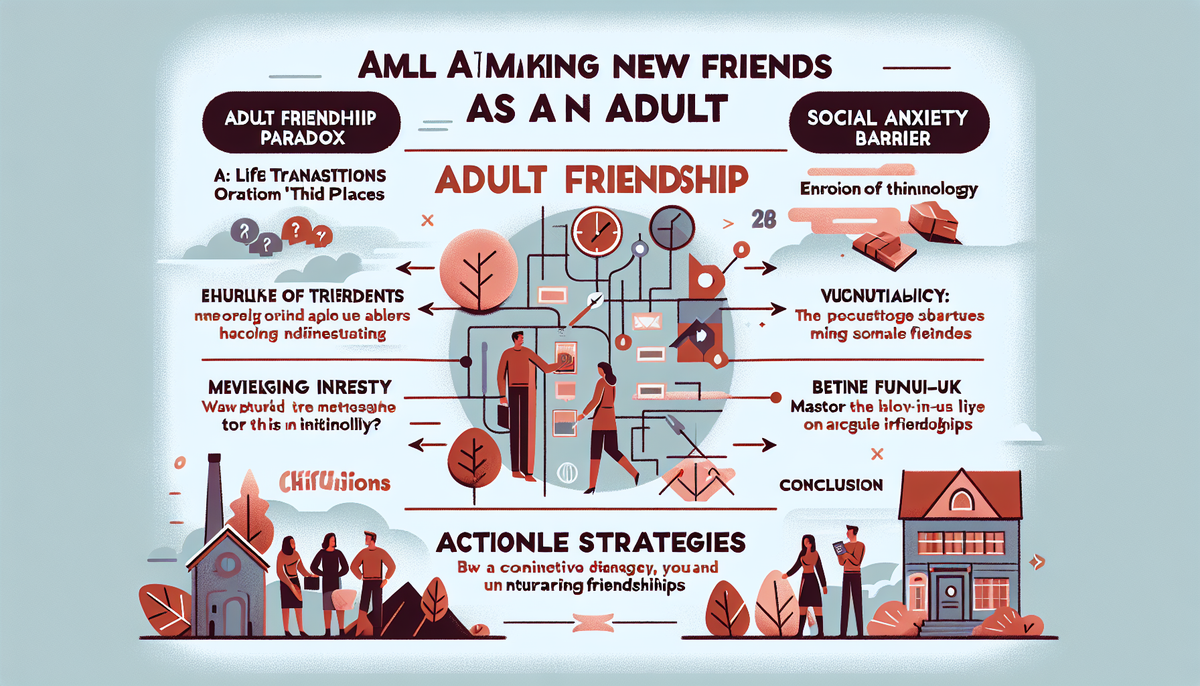Why Making New Friends Feels Hard (And What to Do)

Why Making New Friends Feels Hard (And What to Do)
Remember how friendships seemed to blossom effortlessly during your school days or in college? You were surrounded by people your age, sharing similar experiences and schedules. Yet, as an adult, forging new, meaningful connections can feel like a monumental task. You're not alone in this feeling. The adult friendship paradox is a well-documented phenomenon: we crave deep social connections, but our modern lives often create barriers that make them difficult to form. This article will explore the psychological and logistical hurdles to making new friends in adulthood, tackle the significant role of social anxiety, and provide actionable, practical strategies to help you build the supportive social circle you deserve. We'll show you that it's not about a lack of social skills, but rather a need for a new toolkit for adult connection.
Understanding the Hurdles: Why Is Making Friends Harder Now?
The transition from the structured social environments of youth to the complexities of adult life brings a unique set of challenges. It's not that you've forgotten how to be a friend; it's that the rules of the game have changed. Understanding these hurdles is the first step toward overcoming them.
Life Transitions and Shifting Priorities: Career, Family, and Relocation
Adulthood is a series of significant life transitions. Building a career, getting married, starting a family, or relocating for a new job all demand immense time and energy. Your focus naturally shifts inward toward your immediate responsibilities. Unlike your younger years, where your primary 'job' was being a student among peers, your adult life is segmented. This segmentation leaves less room for the spontaneous, repeated interactions that are the bedrock of friendship formation. Priorities change, and maintaining existing friendships, let alone building new ones, often falls down the to-do list.
The Erosion of 'Third Places': Where Do Adults Hang Out?
Sociologist Ray Oldenburg coined the term 'third places' to describe the locations outside of home (the 'first place') and work (the 'second place') where people gather and interact. Think cafes, parks, community centers, and pubs. These informal public spaces are crucial for social bonding. However, societal trends have led to a decline in these accessible, low-stakes gathering spots. Without these natural environments to Repeatedly bump into potential friends, we are forced to be much more deliberate and intentional, which can feel daunting.
The Vulnerability Factor: Overcoming Fear of Rejection
Making a new friend requires a degree of vulnerability. You have to put yourself out there, initiate a conversation, and risk rejection. As adults, we often have our guard up. We've experienced past hurts, and the fear of being judged or disliked can be paralyzing. This fear can prevent us from taking the small social risks necessary to connect with someone new. It's easier to stick to the safety of our established routines than to face the potential sting of social rejection.
The Time Crunch: Fitting Friendship into a Busy Schedule
Let's be honest: adult schedules are packed. Between work deadlines, family obligations, errands, and self-care, finding a spare evening or weekend can be a logistical nightmare. Friendship requires time to nurture. It needs consistent investment to grow from a casual acquaintance into a deep bond. Arranging a coffee catch-up can involve a dozen back-and-forth texts, making the whole process feel more like a business meeting than a relaxed social activity.
The Social Anxiety Barrier
For many, the biggest obstacle isn't just a busy schedule; it's social anxiety. This goes beyond simple shyness and can be a significant barrier to adult connection. Recognizing and addressing it is crucial for anyone serious about making new friends.
What is Social Anxiety and How Does It Manifest?
Social anxiety is more than just feeling nervous before a party. It's an intense, persistent fear of being watched and judged by others. This fear can lead to physical symptoms like sweating, trembling, a racing heart, or even nausea in social situations. Emotionally, it manifests as extreme self-consciousness and a preoccupation with how you're being perceived. It can cause you to avoid social gatherings altogether or endure them with intense discomfort.
Cognitive Distortions: Breaking Free from Negative Thought Patterns
Social anxiety is fueled by negative thought patterns called cognitive distortions. These might include 'mind-reading' (assuming you know someone is thinking negatively about you) or 'catastrophizing' (imagining the worst-case scenario). You might think, 'If I say something stupid, everyone will think I'm an idiot.' These thoughts are often automatic and irrational, but they feel very real and can sabotage your efforts to connect with others before you even start.
Practical Steps to Manage Social Anxiety in Social Settings
Managing social anxiety is an active process. Start small: challenge a negative thought by asking for evidence. Shift your focus from your internal anxiety to the people around you—listen intently to a conversation instead of monitoring your own performance. Prepare a few open-ended questions in advance to ease the pressure of making conversation. Remember to be kind to yourself; every social interaction is a practice session, not a final exam.
Actionable Strategies for Adult Connection
Understanding the 'why' is important, but the 'how' is what will change your social life. Here are concrete, SEO-optimized strategies to help you move from lonely to connected. This is about being proactive and creating your own opportunities for adult connection.
Step 1: Identify Your Interests and Passions (Finding Your Tribe)
The easiest way to meet people you'll click with is through shared interests. Make a list of things you genuinely enjoy or have always wanted to try. Then, look for groups or classes centered around those activities. This could be a book club, a hiking group, a language class, a pottery workshop, or a recreational sports league. This strategy is effective because it provides a built-in conversation starter and ensures you're meeting people with at least one common interest.
Step 2: Leverage Technology and Social Apps (Wisely)
In the digital age, technology can be a powerful tool for connection. Apps like Meetup are specifically designed to help people find local events and groups based on their interests. Bumble BFF offers a platform for finding platonic friendships. You can also join Facebook groups for local communities or for people who share your hobbies. The key is to use these apps as a bridge to real-life interaction, not as a substitute for it.
Step 3: Master the Art of the Follow-Up (From Acquaintance to Friend)
Meeting someone new is just the first step. The real magic happens in the follow-up. If you have a good conversation with someone, don't leave the next encounter to chance. Mention a specific shared interest and suggest a future activity. For example, 'I really enjoyed our chat about sci-fi novels. I'd love to grab a coffee sometime and hear what you thought of that new book you mentioned.' This transforms a pleasant, fleeting interaction into a potential friendship.
Step 4: Be the Initiator (Hosting, Inviting, and Planning)
Many adults are waiting to be invited, so take the lead. You don't have to throw a huge party. Start small. Invite a new acquaintance for a walk, host a casual potluck for a few people from your yoga class, or organize a happy hour for some colleagues. Being the initiator signals that you are open to new friendships and takes the pressure off others. It puts you in the driver's seat of your social life.
Step 5: Nurturing the Seedling: The Path to Meaningful Friendship
Friendship doesn't happen overnight. It requires consistent effort and nurturing. Be patient and understand that it takes time to build trust and intimacy. Check in with your new connections periodically. Remember details from your conversations and ask about them later. Share about your own life and be a good listener. Consistency shows that you are invested in the friendship and value the other person's presence in your life.
Conclusion: Building Your Circle, One Connection at a Time
Making new friends as an adult is undoubtedly a different experience than when we were younger. It requires more intention, vulnerability, and effort. The barriers, from busy schedules to social anxiety, are real. However, they are not insurmountable. By understanding the challenges, actively managing your mindset, and implementing practical strategies, you can successfully build a rich and supportive social circle. The key is to be proactive and patient. Start today by taking one small step—join a group, text an acquaintance, or simply smile at a neighbor. Every meaningful adult connection you'll ever make will start with a single, intentional step forward.


